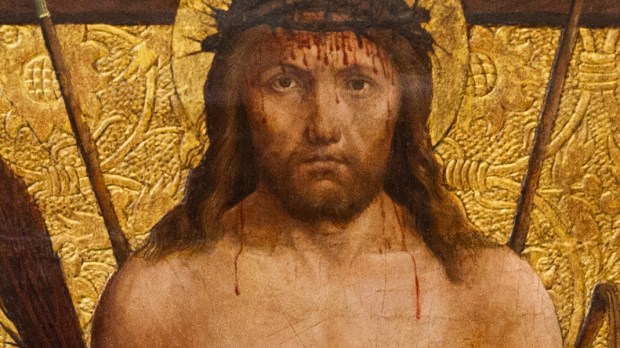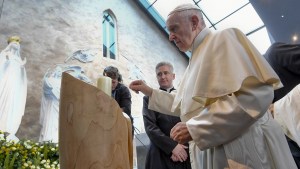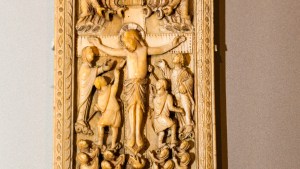Holy Thursday beautifully demonstrates — in Christ’s washing of the feet and agony in the garden — the communion of God and man. The humble descent of the Son into human nature, however, doesn’t end with the Incarnation. It continues downward to the cross. “Love by its very nature tends to an incarnation,” Fulton Sheen wrote, “and an incarnation by its very nature tends to a crucifixion.” Thus, at the conclusion of St. Paul’s ode to the Incarnation, we hear: “He humbled himself and became obedient to the point of death — even death on a cross” (Phil. 2:8).
With the possible exception of the fish, the cross is the most ancient symbol of the Christian faith, and today, by far the most universal. No image summarizes the life of Christ and his followers so directly and clearly. And, undoubtedly, it communicates Christ’s victory over sin and death:
“For the wages of sin is death, but the free gift of God is eternal life in Christ Jesus our Lord” (Rom. 6:23). The cross is salvation, the “way out” (ex-hodos) of evil.
But is it also the “way out” of the world itself? That is to say, is it a symbol of dualistic escapism and pessimism — of fleeing from this world and its problems? No; on the contrary, the cross itself speaks powerfully of the union of the higher and lower worlds — precisely in the union of its vertical and horizontal beams.
Union of worlds
The Scriptures themselves draw out this connection. They consistently speak of God’s “place” above and man’s “place” below: “The heavens are the Lord’s heavens, but the earth he has given to human beings,” (Ps. 115:16). But they also understand those two metaphysical “places” through the lens of the sky above us and the ground below.
When the Bible speaks of heaven, we hear of the stars, moon, and sun; of lightning, thunder, and rainbows; of soaring birds, trees, and mountains. When it speaks of earth, we hear of clay and soil, dust and ashes, grass and flowers, worms and beasts. Just as light and rain falls down from the sky to enliven the soil, so, too, do eternal light and living water fall down to enliven man and the world.
These associations aren’t meant to be taken literally, as if God’s “home” is physically atop the sky. Rather, the dome of the sky symbolizes the transcendent mystery of God’s dwelling, whereas the expanse of the earth symbolizes the familiarity of our own — sky and all. The physical vertical and horizontal (the heavens and the earth) orient us to the metaphysical vertical and horizontal.
What does all this have to do with Good Friday and the cross?
An embrace
Just as Christ is the communion of both God and man, he is also the communion of both God’s place and man’s place. He is the kingdom of God in person, radiating holiness and perfection from above; yet he also embraces man’s world with all its shadows and sorrows, right down to the horrific suffering and death of the cross.
All of this is captured symbolically in the convergence of its two beams, the meeting of the metaphysical vertical and horizontal for the life of the Church, and through the Church, of the world. As G.K. Chesterton wrote:
“The cross, though it has at its head a collision and a contradiction, can extend its four arms for ever without altering its shape. Because it has a paradox in its center it can grow without changing.”
Does this mean that God celebrates all the suffering and sorrow of this fallen world in themselves? No — because such darkness won’t enter his light in the end:
“He will wipe every tear from their eyes. Death will be no more; mourning and crying and pain will be no more” (Rev. 21:4).
It does, however, mean that God embraces and transfigures that suffering and sorrow. After the Resurrection, we are given a striking detail: The wounds in his hands and his side from his Crucifixion remain (John 20:20). The Way doesn’t erase the wounds of earth; it radiates heavenly light through them.
This communion of heaven and earth will one day reach its culmination in the “new heavens and the new earth,” when — far from escaping this world for a heaven above — the new Jerusalem will descend to this world below (Rev. 21:2). In the meantime, the people of God lift high the cross — a symbol not only of deliverance from sin but of God’s embrace of the world:
“For God so loved the world that he gave his only Son, so that everyone who believes in him may not perish but may have eternal life” (John 3:16).




